
95% of researchers rate our articles as excellent or good
Learn more about the work of our research integrity team to safeguard the quality of each article we publish.
Find out more
ORIGINAL RESEARCH article
Front. Phys. , 03 April 2025
Sec. Social Physics
Volume 13 - 2025 | https://doi.org/10.3389/fphy.2025.1524104
This article is part of the Research Topic Integrating Trans-disciplinary Methods between Physics and Linguistics View all articles
The warehouse model, based on differential equations, has been widely employed in the field of network information propagation for an extended period. Numerous studies have revolved around the construction, fitting and simulation of these models. However, there has not been a universal and efficient fitting method applicable to all warehouse models in the realm of information propagation, mainly due to the often challenging nature of solving differential equations in practical scenarios. In this article, we introduce a deep learning-based framework for simulating information propagation dynamics. This framework is grounded in a model that embeds a physical neural network and can be employed for fitting data from sentiment analysis platforms. We apply our framework to classic information propagation dynamic models, achieving favorable fitting results and consistent experimental outcomes, underscoring the advancement of our approach.
Over the past decade, the swift evolution of mobile Internet technology has exerted a profound influence on both production and daily life for all individuals. Simultaneously, the internet has progressively assumed a central role in how people engage with current events and news. While the Internet offers convenience for disseminating public opinion [1], it also poses substantial challenges to the management of public sentiment. The systematic investigation of network communication patterns and a comprehensive understanding of propagation mechanisms represent pivotal topics in contemporary research. Furthermore, these aspects constitute the focal points of government and regulatory agencies tasked with safeguarding network security and governing public sentiment [2]. Hence, a plethora of information propagation models have been proposed for simulating and forecasting public sentiment, conducting interventions and control, or studying policy patterns [3–5]. These models can be broadly categorized into differential equation-based compartment models and topology-based complex network models. In comparison, compartment models have garnered richer research attention due to their clarity in addressing macroscopic factors. This paper primarily focuses on the simulations of compartment models, encompassing the evolution of various groups during the information propagation process and the inverse problem-solving for pertinent propagation parameters.
Deep learning, owing to its formidable feature extraction capabilities, has found extensive applications across diverse domains [6]. It autonomously acquires high-dimensional information from extensive datasets, thereby reducing the need for conventional feature engineering. Nevertheless, the adoption of pure data-driven deep learning methods within the realm of information dissemination remains limited due to the reliance on large-scale and high-quality data [7]. In the domain of information dissemination, the acquisition of high-quality labeled data is challenging, and privacy concerns often hinder access to a significant portion of information. These factors present substantial obstacles to the integration of deep learning techniques. Furthermore, deep learning, functioning as a black-box model, lacks interpretability in its underlying mechanisms, thus impeding its broad applicability to various scientific problems. Physics-informed neural networks (PINNs) [8, 9] have, to a certain extent, alleviated these issues. They merge data-driven deep learning with differential equations, enhancing the interpretability of deep learning and streamlining the solving of differential equations. With the advancement of technology, PINNs have made significant research contributions in various fields, including fluid dynamics [10], materials science [11], aerospace engineering [12], and biochemistry [13]. Furthermore, numerous derivative models rooted in PINNs have emerged to cater to diverse tasks, such as those involving restricted initial or boundary conditions [8].
Since the onset of the COVID-19 pandemic, a variety of compartmental models have been introduced, serving as enhanced versions of the Susceptible-Infected-Recovered (SIR) compartmental model to investigate various aspects of disease spread [14]. Yin et al. applied the traditional SIR model to the field of information propagation and proposed the Susceptible-Forwarding-Immune (SFI) model based on the cumulative retweet volume of the Sina-microblog platform to predict the dissemination trend of a single piece of information [15]. Xiao et al. fully considered the anti-rumor information and user’s psychology, and constructed the SKIR rumor propagation model [16], which can effectively grasp the dynamic change laws of anti-rumor information on the information propagation process. Yin et al. constructed the Multiple-Information Susceptible-Discussion-Immune (M-SDI) dynamic model to understand the propagation pattern of public opinion on social networks by creatively considering public repeated participation in new topics [17]. Moreover, many scholars have extended the traditional SIR model to information dissemination from various perspectives, such as forgetting mechanisms, individual characteristics, and behaviors [18–20]. Recently, the application of deep learning in infectious disease models has become a research hotspot. For instance, Malinzi et al. applied a Physics-Informed Neural Network (PINN) to a Susceptible-Infected-Recovered-Deceased (SIRD) model, indicating that their PINN model outperformed all other data analysis models, even when trained with minimal data [21]. Heldmann et al. explored different models involving integer-order, fractional-order, and time-delay systems expressed as systems of Ordinary Differential Equations (ODEs). Research on complex systems based on systems of ODEs is very common and widely used in the field of mathematical physics, such as in laser physics, among others [22, 23]. PINNs were chosen for their capability to simultaneously perform parameter inference and simulate both observed and unobserved dynamics [24]. Cai et al. employed the novel fractional Physics-Informed Neural Networks (fPINNs) deep learning framework to calibrate the unknown parameters of a Susceptible-Exposed-Infected-Removed (SEIR) model [25]. Hao et al. also used the PINN method to model the compartment model and used first-order local sensitivity analysis to investigate the most influential parameters in the basic SIR model, and the results showed that reproduction/mortality had the greatest impact on all compartments of the SIR model [26].
Therefore, our objective is to develop a PINN framework for simulating the dynamics of network information propagation. Although there are certain similarities between infectious disease dynamics and network information dissemination, and the effectiveness of the PINNs method has been demonstrated in various domains, it is important to note that limited availability of real-world data and the complexity of mechanisms and influencing factors in information dissemination pose challenges in this field. Hence, constructing such a simulation system and validating its efficacy are crucial for advancing research on information propagation dynamics, providing valuable methodological guidance for subsequent related studies.
The organization of this article is as follows: Section 2 provides a foundation in single-information propagation dynamics and the fundamentals of PINNs. Section 3 outlines our proposed simulation framework for information propagation dynamics. Section 4 presents numerical experiments conducted using our proposed framework on classic information propagation dynamic models. Finally, Section 5 offers a summary and analysis of our work.
Describing the information propagation process often necessitates the introduction of partial differential equations (PDEs) or ordinary differential equations (ODEs) to depict the dynamic state of information dissemination [27]. Analogous to dynamic equations used in infectious disease modeling, a multitude of ordinary differential equations, grounded in various propagation models or laws, have been employed to simulate the information propagation process, which makes it possible for real-world data fitting and validations of the propagation dynamic model. However, traditional methods for solving differential equations tend to be intricate and susceptible to the influence of initial conditions or boundary conditions [28]. Furthermore, the data employed for fitting often contains noise, significantly impacting the solutions derived from these differential equations. It is worth noting that problem-solving within the domain of information propagation can be categorized into two distinct types: forward problem-solving and inverse problem-solving. Forward problem-solving involves scenarios where the equation’s parameters are known, and the focus is on changes in each dependent variable within the differential equation. In contrast, inverse problem-solving pertains to situations in which the unknown parameters of the differential equation are reverse-engineered, leveraging partial data on dependent variables obtained from real-world observations, where the parameters serve to characterize the system’s propagation characteristics. In addressing inverse problems, the least squares method is frequently introduced for parameter fitting, which is often contingent on well-designed initial values or boundaries [8].
Single information dissemination is the basic structure of network public opinion information dissemination, and the process of an individual participating in single information dissemination is also the basis of single information dissemination analysis [15]. The dynamic model of single information spreading based on forwarding is called Susceptible-Forwarding-Immune (SFI) model. Here, the sum of the total number of people in susceptible state (
where the average contact rate
For the SFI dynamic model with single information dissemination, when fitting the actual case data, the above three key variables in the model will be formed as an unknown parameter vector and estimated to make the cumulative number consistent with the real data. Therefore, to find the best fit for the data is to find the best combination of parameters to minimize the error between the estimated and real values. In general, the least squares method is the most widely used in the fitting of information propagation dynamics research, where other machine learning methods such as the Monte Carlo method are also used. Since the model does not have an analytical formula and its form is very complex, minimizing the sum of squared deviations becomes a nonlinear least squares problem.
According to the universal approximation theorem, the neural network can be regarded as a general nonlinear function approximator, and the modeling process of a differential equation is to find nonlinear functions that meet relevant constraints [8]. Using neural networks to approximate model differential equations has become a research hotspot. The automatic differentiation technology in deep neural networks can be naturally applied to the calculation in differential equations and the constraint conditions of differential form are integrated into the loss function design of neural networks, so as to obtain neural networks with physical model constraints, which is the most basic idea to design embedded physical neural networks [29]. The PINNs model aims to establish a correlation between deep neural networks and various physical phenomena represented as systems of differential equations, thereby enhancing the interpretability of neural networks and expediting the resolution of differential equations. In the common application model of PINNs, the incorporation of physical information is primarily manifested in the loss function. The implementation of PINNs involves the integration of physics principles and neural networks through a well-designed approach, which does not pose significant challenges. First, the neural network is constructed, where the parameters are randomly initialized. The initialized neural network takes in the independent variables of the system of differential equations and produces the solutions that are needed to be optimized for the dependent variable of the system. Secondly, the output value of the dependent variable generated by the neural network fails to provide evidence for the validity of the equation, and this discrepancy constitutes the loss of equations. At the same time, the loss of the data level and the loss of the boundary condition are introduced to combine with the given weights, which become the loss of the whole model. Finally, the gradient descent method and other optimization methods are used to train the model and fit the differential equation.
Before data-driven machine learning made great progress, many physics and engineering fields were physically model-driven. Over the years, these fields had accumulated a wealth of physical models, most of which were described in the form of partial differential equations, such as Navier-Stokes equations in fluid dynamics [30], Maxwell equations in electromagnetic field theory [31] and Schrodinger equation in quantum mechanics [32]. Directly solving the physical model can make accurate predictions, but it faces the problems of too large errors caused by simple physical models, too high solution complexity caused by complex physical models and too large solution errors caused by missing or inaccurate measurement of physical model parameters and initial boundary values. The traditional numerical methods of partial differential equations face great challenges in solving inverse problems, complex geometric regions and high-dimensional space. In contrast, the classical machine learning algorithms are purely data-driven. The task of training a supervised machine learning model is to establish a functional mapping from the input data to the output data, that is, to learn a specific model from the pre-obtained training data and the pre-defined algorithm structure. However, in many physical and engineering fields, these training data often imply part of the prior knowledge, such as the law of conservation of momentum, the law of conservation of mass and so on [29]. PINNs combine the advantages of data-driven machine learning models and physical models. Under the condition of a small amount of training data, physics-based neural networks can train models satisfying physical constraints automatically, have better generalization performance while ensuring accuracy, and predict important physical parameters of the model [33].
The information propagation process in the compartment model can be abstracted into a dynamic pattern, as illustrated in Figure 1. Here,
Throughout this paper, we make the assumption that the underlying model of single-information network propagation follows the structure depicted in the SFI model, which can be mathematically represented by a system of ordinary differential equations. All propagation dynamics based on compartment models can be described using either systems of partial differential equations or ordinary differential equations. Therefore, our focus lies on the SFI model as it serves as a fundamental framework for studying information dissemination. This foundation allows us to derive various single information dissemination models under different scenarios or influence factors, which share similar and universal sets of differential equations. Taking the SFI model as an illustrative example, it is important to note that the total number of users in different states within the compartment model remains constant throughout its dynamic process, where changes are reflected through mutual transformations between different groups.
In order to fit the real data combined with the platform data, relevant scholars introduce the cumulative forwarding number
Based on the method of physics-informed neural networks, we introduce a deep learning framework informed by the information propagation dynamic equations that describe the single information propagation processes and their derivatives. Most studies express the information propagation dynamics as ordinary differential equations, and some introduce other factors besides time as independent variables of the equations to construct partial differential equations. Our PINN modeling framework takes into account the two types of equations simultaneously, the only difference between the two ways is that the input of the neural network is one or more.
In our framework shown in Figure 2, the Application Program Interface (API) is used to obtain real propagation data from the social media platform, including the changes of the cumulative forwarding number of a certain news over time. Therefore, the time
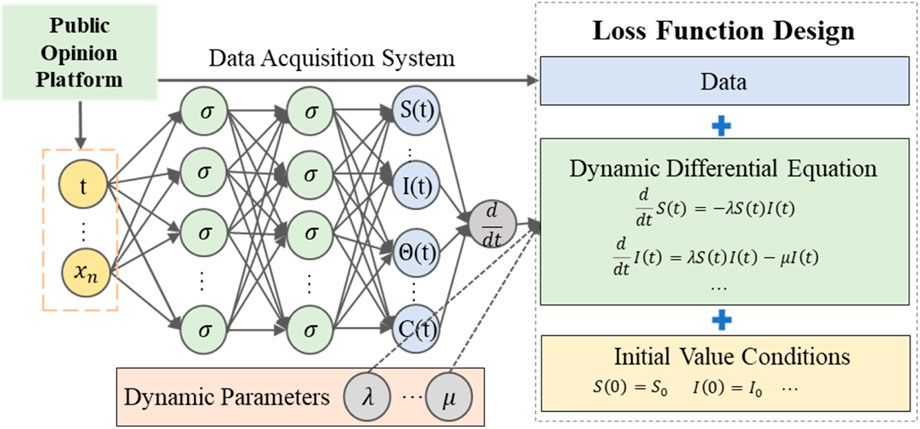
Figure 2. The embedded physical neural network framework for information propagation dynamics, which consists of three parts: a data acquisition system, a fully connected neural network, and a loss function.
A neural network with parameters
The next key step is to constrain the neural network to satisfy the scattered observations of
The loss function is designed as shown in Equation 5, where the variable
The third auxiliary loss term
Remark 1. In the actual training process, due to the extensive data requirements for neural network training and the limited data collected from social media platforms, our framework necessitates the sampling of points within the defined domain to acquire a more substantial dataset, which is essential to facilitate the training of our PINN model.
Remark 2. The algorithm is implemented in Python using paddlepaddle. The width and depth of the neural networks depend on the size of the equations and the complexity of the information propagation dynamics. We use the sigmoid activation function except for the last neural network layer which uses sigmoid function to scale the data at different dimensions. For the training, we use a combination of two optimizers, Adam and L-BFGS, to optimize the
Stage 1. The network is initially trained using the two supervised losses
Stage 2. We further train the network using the three losses.
In this section, we demonstrate the application of the proposed framework in the context of dynamics in public opinion propagation. To showcase the advanced and generalized nature of the framework, based on data accessibility, we primarily utilize some classic works previously published by our team in numerical experiments. These studies mainly encompass the classical SFI model, the SFI model considering the emotional factors, the SFI model considering the different stages, and a propagation dynamic model based on differential equation systems. Due to slight variations among different variables of the SFI models, there need to be some differences in the fully connected neural network used in our framework - primarily regarding input neurons, output neurons, and neurons employed for training parameters in inverse problems. However, aspects such as activation functions and learning rates in our models remain consistent. To accommodate the efficiency requirements of our training model, adjustments can be made to vary the number of layers in our neural network according to practical considerations. More importantly, according to the given varying events of different propagation dynamics models during the actual data fitting process, scaling may be required at differing degrees, which will be described in subsequent parts. The data and codes in this section are publicly available at: https://github.com/zhangzhiqiangccm/PINN_attempt.
As mentioned in the second section of this paper, the SFI model [15], a classic compartmental model in the field of network information dissemination, serves as the foundational framework for numerous works. Consequently, we employed the proposed framework for simulating the dynamic process of single information propagation to compare with the traditional solution method in the SFI model, encompassing the fitting of population quantities for various states and the prediction of the propagation dynamic parameters. Similarly, we employed the same forwarding data collected from a hot topic on the Chinese Sina-microblog as the foundational dataset for our framework. To expedite the convergence of the neural network, we also applied data scaling and subsequently calculated the Mean Squared Error for the fitted results. The ultimate fitting performance is illustrated in Figure 3:
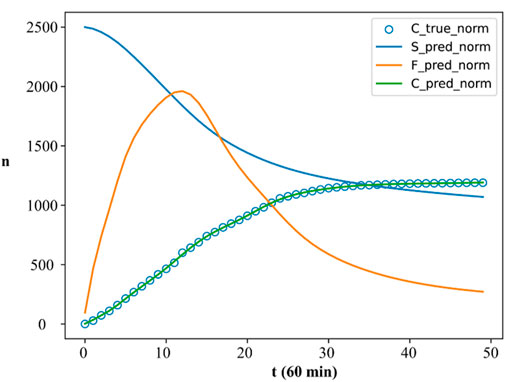
Figure 3. The fitting results of the SFI model based on our proposed framework. Note: The horizontal axis in the picture is time, and the vertical axis is the value of C(t). In the legend, “C_true_norm” represents the true value of the cumulative forwarding volume, “S_pred_norm”, “F_pred_norm” and “C_pred_norm” represent the predicted S(t), F(t) and C(t) respectively.
The total number
The emotion-based susceptible-forwarding-immune (E-SFI) [37] propagation dynamic model incorporates the categorization of emotions into positive, neutral, and negative, aiming to describe the process of emotional choices made by users in various states and investigate the information propagation that influences public sentiment. To accommodate this model in our framework, we have to increase the dimensions of the output layer in the neural network and expand the data for supervising model training. Consequently, we conducted simulations and training using original data from event one in the E-SFI model. The training process still utilized an 8-layer fully connected neural network with initial values determined by real data. The sampling and scaling approaches adopted in this part are similar to those in section 4.1, but with a greater number of neurons in the output layer to generate cumulative forwarding numbers under the three emotional states and produce propagation dynamics parameters. The fitting results in Figure 4 demonstrate that our framework outperforms the E-SFI model in accurately fitting real data including all the emotion types.
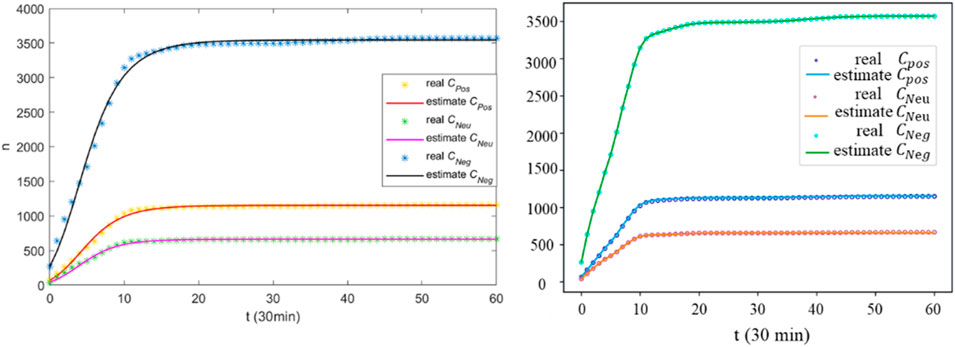
Figure 4. The comparison results between the original fitting outcomes of the E-SFI model (left) and those obtained from our proposed framework (right). Note:
The two-stage rumor propagation dynamic model aims to design effective strategies for controlling rumors, where the first stage of rumor propagation is characterized by the susceptible/educated-infected-recovered (SO-S/EIR) dynamics and the second stage is characterized by the susceptible/educated-infected-denied-recovered (C-S/EIDR) dynamics [38]. The conventional least-squares fitting method is inadequate for modeling the two-stage rumor propagation dynamics discussed in this study, making it become necessary to separately fit each stage individually. The advantage of our framework lies in the robust fitting capability of neural networks, which enables us to accurately fit the data without the need for data splitting. Based on data and theory from the original paper, we applied the PINN framework for data fitting, of which notable results for both stages are depicted in Figure 5. Compared with the results in the original model, the fitting effect of our model is not satisfactory for the mutation in the two stages, but it performs well at other locations. Furthermore, our proposed framework demonstrates its capability to fit the curves from two distinct stages, thereby enhancing the efficiency of data fitting.
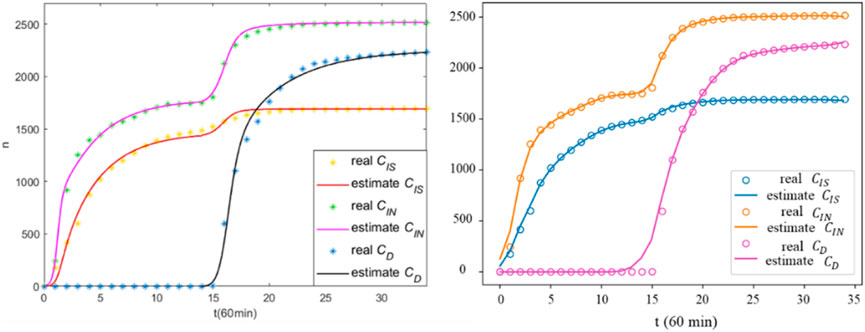
Figure 5. The comparison results between the original fitting outcomes of the TS-SFI model (left) and those obtained from our proposed framework (right). Note:
In addition to the time variable
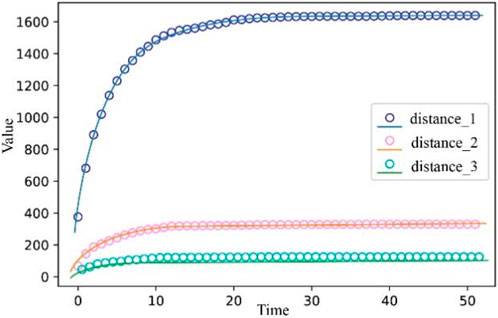
Figure 6. The fitting results of the SFI model for PDE based on our proposed framework. Note: Distance_1, distance_2, and distance_3 represent the three different social distances used in the experiment. The points in the figure represent the real data values, and the curves are the predicted variable values.
The aforementioned experiments have demonstrated the effectiveness of the proposed framework in the context of information dissemination dynamics. Additionally, we seek to validate the robustness of model by adjusting the weights in three key aspects in the SFI model: data, equations and initial conditions and corresponding results are depicted in Figure 7. The values after “Data”, “Eq”, and “Ic” represent the respective proportions of data loss, equation loss, and initial condition loss shown in Figure 7. There is significant fluctuation in results when altering the weights of equations, indicating their crucial role throughout the entire fitting process. Conversely, alterations of the curves are not prominently evident under the changes of initial value conditions. In traditional methods, simulation results are often heavily influenced by initial values, leading that only an appropriate initial value can obtain a reasonable fit. Our proposed framework reduces the susceptibility to variations in initial values while ensuring both fitting effectiveness and model robustness. Furthermore, the overall propagation trends of propagation populations remain unchanged, highlighting the intrinsic mechanisms inherent within the SFI model.
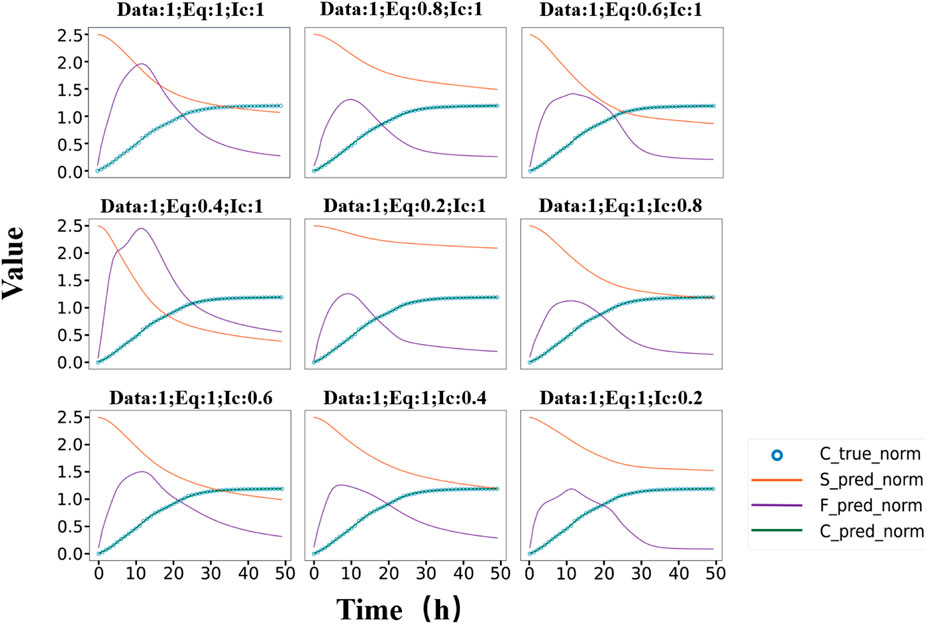
Figure 7. Fitting results of the SFI model under different loss weight configurations within the proposed framework. Note: The annotation “Data:1; Eq:1; Ic:1”indicates the weighting ratio assigned to data constraint, equations, and initial condition terms in the composite loss function. To better display the image, the values on the vertical axis have been reduced by a factor of 1,000; the actual quantities should be 1,000 times greater than those indicated in the figure.
The loss results of each model are computed after 100,000 iterations in Table 1. From the results, it is evident that the PSFI model outperforms both the SFI and E-SFI models in terms of training outcomes. Despite its more intricate structure and resulting complex system of differential equations, the PSFI model benefits from a larger amount of supervised signal data, enabling superior training. In contrast, the two-stage rumor propagation dynamic model based on the SFI model exhibits more complexity due to its lack of sufficient supervised signal data, leading to poorer fitting performance. Ultimately, simulation results based on partial differential equations slightly surpass those based on ordinary differential equations, with only minor differences observed in terms of independent variables in the input model. Thus, to some extent, incorporating social distance variable into the input model significantly impacts propagation dynamics fitting. Moreover, in our proposed framework, data loss often constitutes a substantial portion of the overall loss function, since losses at data level tend to be numerically greater than those incurred by the other two components.
Our framework integrates the forward and inverse problems in the context of information dissemination dynamics. In contrast to conventional approaches, which solve the model parameters and then conduct forward numerical simulations based on these parameters, our approach offers greater efficiency. However, it should be noted that the values of parameters obtained from our framework cannot be directly compared to those obtained through inverse problem-solving methods. This is because the parameters within the neural network in our framework are also an integral part of the overall system, despite its inherent complexity. Our framework primarily focuses on data fitting and predicting the numbers of user in each propagation state. While various modules within the framework interact and depend on each other, minor adjustments are still necessary to align with real-world scenarios. Among these adjustments, scaling pertaining to data handling is crucial way in our framework. Firstly, in propagation dynamic models, there can be substantial numerical disparities in representing different states or groups, ranging from a few to thousands or more, resulting in normalizing these numerical values becoming essential. In our framework, except for the final layer which lacks an activation function, the activation functions in the hidden layers of the neural network are chosen as
In this study, we introduce the method of embedded physical neural networks to construct a framework suitable for modeling the dynamics of public opinion propagation based on partial differential equations. This innovative approach combines the automatic differentiation mechanism of neural networks with partial differential equations through the design of a loss function, enabling more efficient fitting for real data. Unlike other methods, our approach does not require grid drawing and is insensitive to initial or boundary values [31]. Furthermore, it unifies ordinary and partial differential equations solving by converting time
We apply this proposed framework to solve various classic scenarios such as the SFI and E-SFI models in public opinion propagation dynamics research. Comparative results demonstrate that our method outperforms existing models in terms of fitting accuracy without compromising computational efficiency. Although our proposed framework can obtain good results, there are also some shortcomings. Firstly, in the design of the loss function of the neural network, the weights of the data-related loss and the equation-related loss need to be determined by ourselves, because the two have large differences in absolute values, which need to be adjusted according to the specific problem and real data to avoid vanishing or exploding gradients. In addition, some noise can not be avoided to exist in the data we collected from public opinion platforms, which may lead to the phenomenon of overfitting.
The original contributions presented in the study are included in the article/supplementary material, further inquiries can be directed to the corresponding author.
YW: Methodology, Software, Data curation, Writing–review and editing. ZZ: Methodology, Software, Data curation, Writing–review and editing. JWu: Conceptualization, Methodology, Writing–review and editing. JWa: Formal Analysis, Validation, Visualization, Writing–review and editing. YZ: Methodology, Validation, Writing–review and editing. FY: Writing–review and editing.
The author(s) declare that financial support was received for the research and/or publication of this article. The work was supported by the Beijing Natural Science Foundation (No. 4232015); the National Natural Science Foundation of China (No. 62372418); the State Key Laboratory of Media Convergence and Communication, Communication University of China; the Fundamental Research Funds for the Central Universities; the High-quality and Cutting-edge Disciplines Construction Project for Universities in Beijing (Internet Information, Communication University of China). JW was funded by the Natural Science and Engineering Research Council of Canada; and by the Canada Research Chair Program.
Author YZ was employed by Baidu.
The remaining authors declare that the research was conducted in the absence of any commercial or financial relationships that could be construed as a potential conflict of interest.
The author(s) declare that no Generative AI was used in the creation of this manuscript.
All claims expressed in this article are solely those of the authors and do not necessarily represent those of their affiliated organizations, or those of the publisher, the editors and the reviewers. Any product that may be evaluated in this article, or claim that may be made by its manufacturer, is not guaranteed or endorsed by the publisher.
1. Chen Y, Li Y, Wang Z, Quintero AJ, Yang C, Ji W. Rapid perception of public opinion in emergency events through social media. Nat hazards Rev (2022) 23(2):23. doi:10.1061/(asce)nh.1527-6996.0000547
2. Barbara N, Clyde W. Trends in abortion attitudes: from roe to dobbs. Public Opin Q (2023)(2) 2. doi:10.1093/poq/nfad014
3. Yin F, Pan Y, Tang X, Wu C, Jin Z, Wu J. An information propagation network dynamic considering multi-platform influences. Appl Math Lett (2022) 133:108231. doi:10.1016/j.aml.2022.108231
4. Yin F, Wu Z, Shao X, Tang X, Liang T, Wu J. Topic-a cluster of relevant messages-propagation dynamics: a modeling study of the impact of user repeated forwarding behaviors. Appl Mathematics Lett (2022) 127:107819-. doi:10.1016/j.aml.2021.107819
5. Yin F, Zhu X, Shao X, Xia X, Pan Y, Wu J. Modeling and quantifying the influence of opinion involving opinion leaders on delayed information propagation dynamics. Appl Mathematics Lett (2021) 121(4):107356. doi:10.1016/j.aml.2021.107356
6. Vargas R, Mosavi A, Ruiz R. DEEP LEARNING: A REVIEW. Adv Intell Syst Comput (2017) 5(2). doi:10.20944/preprints201810.0218.v1
7. Dong S, Wang P, Abbas K. A survey on deep learning and its applications. Computer Sci Rev (2021) 40:100379. doi:10.1016/j.cosrev.2021.100379
8. Cuomo S, Di Cola VS, Giampaolo F, Rozza G, Raissi M, Piccialli F. Scientific machine learning through physics–informed neural networks: where we are and what's next. J Scientific Comput (2022) 92(3):88–62. doi:10.1007/s10915-022-01939-z
9. Raissi M, Perdikaris P, Karniadakis GE. Physics-informed neural networks: a deep learning framework for solving forward and inverse problems involving nonlinear partial differential equations. J Comput Phys (2018) 378:686–707. doi:10.1016/j.jcp.2018.10.045
10. Cai S, Mao Z, Wang Z, Yin M, Karniadakis GE. Physics-informed neural networks (PINNs) for fluid mechanics: a review. Chin J Theor Appl Mech (2021) 37(12):1727–38. doi:10.1007/s10409-021-01148-1
11. Chen Y, Lu L, Karniadakis GE, Dal Negro L. Physics-informed neural networks for inverse problems in nano-optics and metamaterials. Opt Express (2020) 28(8):11618. doi:10.1364/oe.384875
12. Almajid MM, Abu-Alsaud MO. Prediction of porous media fluid flow using physics informed neural networks. J Pet Sci Eng (2021) 208:109205. doi:10.1016/j.petrol.2021.109205
13. Niaki SA, Haghighat E, Campbell T, Poursartib A, Vazir R. Physics-informed neural network for modelling the thermochemical curing process of composite-tool systems during manufacture. Compu. Meth. Appl. Mec. Eng (2020) 384 113959. doi:10.1016/j.cma.2021.113959
14. Brugnano FZP, Iavernaro F, Zanzottera P. A multiregional extension of the SIR model, with application to the COVID-19 spread in Italy. Math Methods Appl Sci (2021) 44(6):4414–27. doi:10.1002/mma.7039
15. Yin F, Shao X, Wu J. Nearcasting forwarding behaviors and information propagation in Chinese Sina-Microblog. Math Biosciences Eng (2019) 16(5):5380–94. doi:10.3934/mbe.2019268
16. Xiao Y, Chen D, Wei S, Li Q, Wang H, Xu M. Rumor propagation dynamic model based on evolutionary game and anti-rumor. Nonlinear Dyn (2019) 95:523–39. doi:10.1007/s11071-018-4579-1
17. Yin F, Lv J, Zhang X, Xia X, Wu J. COVID-19 information propagation dynamics in the Chinese Sina-microblog. Math Biosciences Eng (2020) 17(3):2676–92. doi:10.3934/mbe.2020146
18. Wang L, Song N, Ma C, He B, Huo L. Rumor spreading model considering the activity of spreaders in the homogeneous network. Physica A: Stat Mech its Appl (2017) 468:855–65. doi:10.1016/j.physa.2016.11.039
19. Liu Y, Wang B, Wu B, Shang S, Zhang Y, Shi C. Characterizing super-spreading in microblog: an epidemic-based information propagation model. Physica A: Stat Mech its Appl (2016) 463:202–18. doi:10.1016/j.physa.2016.07.022
20. Su Q, Huang J, Zhao X. An information propagation model considering incomplete reading behavior in microblog. Physica A: Stat Mech its Appl (2015) 419:55–63. doi:10.1016/j.physa.2014.10.042
21. Malinzi J, Gwebu S, Motsa S. Determining COVID-19 dynamics using physics informed neural networks. Axioms (2022) 11(3):121. doi:10.3390/axioms11030121
22. Meucci R, Euzzor S, Tito Arecchi F, Ginoux JM. Minimal universal model for chaos in laser with feedback. Int J Bifurcation Chaos (2021) 31(04):2130013. doi:10.1142/s0218127421300135
23. Concas R, Montori A, Pugliese E, Perinelli A, Ricci L, Meucci R. Analysis of an improved circuit for laser chaos and its synchronization. IEEE Access (2024) 12:100602–10. doi:10.1109/access.2024.3409875
24. Heldmann F, Berkhahn S, Ehrhardt M, Klamroth K. PINN training using biobjective optimization: the trade-off between data loss and residual loss. J Comput Phys (2023) 488:112211. doi:10.1016/j.jcp.2023.112211
25. Cai M, Em Karniadakis G, Li C. Fractional SEIR model and data-driven predictions of COVID-19 dynamics of Omicron variant. Chaos: An Interdiscip J Nonlinear Sci (2022) 32(7):071101. doi:10.1063/5.0099450
27. Lazebnik T. Computational applications of extended SIR models: a review focused on airborne pandemics. Ecol Model (2023) 483:110422. doi:10.1016/j.ecolmodel.2023.110422
28. Vadyala SR, Betgeri SN, Matthews JC, Matthews E. A review of physics-based machine learning in civil engineering. Results Eng (2022) 13:100316. doi:10.1016/j.rineng.2021.100316
29. Karniadakis GE, Kevrekidis IG, Lu L, Perdikaris P, Wang S, Yang L. Physics-informed machine learning. Nat Rev Phys (2021) 3(6):422–40. doi:10.1038/s42254-021-00314-5
30. Eivazi H, Tahani M, Schlatter P, Vinuesa R. Physics-informed neural networks for solving Reynolds-averaged Navier–Stokes equations. Phys Fluids (2022) 34(7). doi:10.1063/5.0095270
31. Bennini A, Lanteri S, Valentin F, Gomes TA., Miguez da Silva L. PINNs for the time-domain Maxwell equations-Preliminary results. In: Performance Computing Conference; September, 2022; Porto Alegre (2023).
32. Wang L, Yan Z. Data-driven rogue waves and parameter discovery in the defocusing nonlinear Schrödinger equation with a potential using the PINN deep learning. Phys Lett A (2021) 404:127408. doi:10.1016/j.physleta.2021.127408
33. Lawal ZK, Yassin H, Lai DTC, Che Idris A. Physics-informed neural network (PINN) evolution and beyond: a systematic literature review and bibliometric analysis. Big Data Cogn Comput (2022) 6(4):140. doi:10.3390/bdcc6040140
34. Geng L, Yang S, Wang K, Zhou Q. Modeling public opinion dissemination in a multilayer network with SEIR model based on real social networks. Eng Appl Artif Intelligence (2023) 125:106719. doi:10.1016/j.engappai.2023.106719
35. Yan Z, Zhou X, Du R. An enhanced SIR dynamic model: the timing and changes in public opinion in the process of information diffusion. Electron Commerce Res (2024) 24(3):2021–44. doi:10.1007/s10660-022-09608-x
36. Yuan J, Shi J, Wang J, Liu W. Modelling network public opinion polarization based on SIR model considering dynamic network structure. Alexandria Eng J (2022) 61(6):4557–71. doi:10.1016/j.aej.2021.10.014
37. Yin F, Xia X, Zhang X, Zhang M, Lv J, Wu J. Modelling the dynamic emotional information propagation and guiding the public sentiment in the Chinese Sina-microblog. Appl Mathematics Comput (2021) 396:125884. doi:10.1016/j.amc.2020.125884
38. Yin F, Jiang X, Qian X, Xia X, Pan Y, Wu J. Modeling and quantifying the influence of rumor and counter-rumor on information propagation dynamics. Chaos, Solitons and Fractals (2022) 162:112392. doi:10.1016/j.chaos.2022.112392
Keywords: dynamic model, information propagation, deep learning, PINNs, simulation and fitting
Citation: Wu Y, Zhang Z, Wu J, Wang J, Zhou Y and Yin F (2025) An advanced deep learning framework for simulating information propagation dynamics. Front. Phys. 13:1524104. doi: 10.3389/fphy.2025.1524104
Received: 07 November 2024; Accepted: 17 March 2025;
Published: 03 April 2025.
Edited by:
Kazuya Hayata, Sapporo Gakuin University, JapanReviewed by:
Riccardo Meucci, National Research Council (CNR), ItalyCopyright © 2025 Wu, Zhang, Wu, Wang, Zhou and Yin. This is an open-access article distributed under the terms of the Creative Commons Attribution License (CC BY). The use, distribution or reproduction in other forums is permitted, provided the original author(s) and the copyright owner(s) are credited and that the original publication in this journal is cited, in accordance with accepted academic practice. No use, distribution or reproduction is permitted which does not comply with these terms.
*Correspondence: Fulian Yin, eWluZnVsaWFuQGN1Yy5lZHUuY24=
†These authors have contributed equally to this work and share first authorship
Disclaimer: All claims expressed in this article are solely those of the authors and do not necessarily represent those of their affiliated organizations, or those of the publisher, the editors and the reviewers. Any product that may be evaluated in this article or claim that may be made by its manufacturer is not guaranteed or endorsed by the publisher.
Research integrity at Frontiers

Learn more about the work of our research integrity team to safeguard the quality of each article we publish.